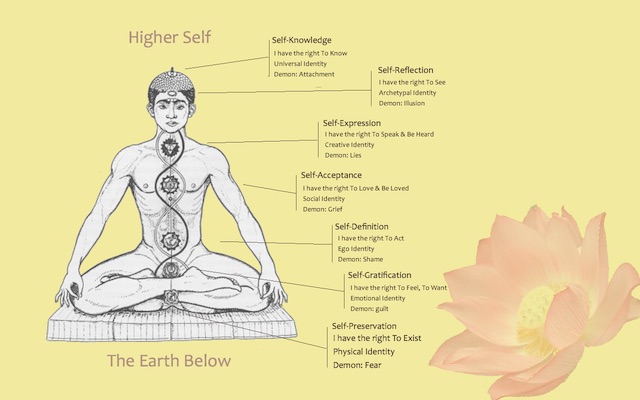
Them chakras—the 7 energy centers plotted along seven sites from our pelvis to crown—seem mysterious.
But they’re not.
Try this exercise:
Sit with your back straight.
Close your eyes.
Walk your feeling touch through your body with your mind’s eye, as if a finger were poking at different places inside your being.
Feel your pelvic floor.
Walk up to your heart.
Feel it with your imagination. Sense toward it.
Sense your throat.
Sense your brow.
Sense the crown of your head.
We skipped a couple of the low chakras for the sake of brevity, but what did you feel at each one of these stops?
Most of us have some form of synesthesia—i.e., we see colors, hear sounds or feel things in response to some accompanying stimuli. For example, if I close my eyes, I might see colors when I listen to a Charlie Puth song.
So, maybe when you did this, you had some image, sound or emotion come to you.
The point is, we feel things of different qualities in different places in the body. Usually, as we go lower, things get darker, denser and more primal in their quality—and as we go higher things feel brighter and lighter and there might be clearer sensations of oscillation or vibration.
This approximates our body psychology. Sex, elimination and digestion happen in the low body; heart-love, complex ideation and conceptualization happen higher.
This is a rough approximation of the subtle-body chakra system.
Of course, the map of the chakras is much more precise, as is the map of each one of these energy centers individually—at the pelvic floor, pit of the pelvis, belly button, heart, throat, brow and scalp—respectively.
For healing purposes, this healing exercise can be enhanced by a specific way of breathing.
We can sip the breath seven times, filling up the lungs and—by imagination—the body, as if it was an empty bottle, stopping at each imagined chakra center as we along.
Sip. Stop at pelvic floor.
Sip. Stop at pelvic bowl.
Sip. Stop at belly button.
Sip. Stop at heart, and all the way up the rest of the chakras.
We then empty out the breath the same way.
Each sip or exhalation of the breath—on the way to filling the lungs up completely or emptying them completely—is stop on the array of flowers we call the chakras.
As we stop there, we do a moment’s diagnosis, and a little clearing of the energy at each one of those areas by bringing our attention to it.
We bring some power and attention to each or our seven chakras.
As the yoga tradition says, power follows attention.
I’ve offered you one of the simplest chakra healing practices.
Please give it a go, and report back in the comments below.
.
Author: Eric Shaw
Image: Scott Leslie/Flickr
Editor: Emily Bartran


 Share on bsky
Share on bsky




Read 0 comments and reply